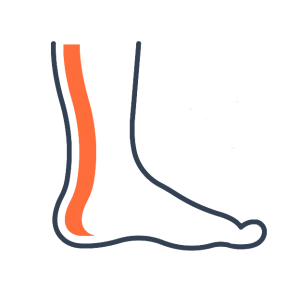The Achilles tendon is a large tendon at the back of the ankle, which originates as the gastrocnemius and soleus (calf muscles) and then attaches to the calcaneus (heel bone). Essentially, the Achilles tendon connects the leg muscles to the foot. You use these muscles to push off during walking and running, walk around on tip-toes, do box jumps, etc.
Achilles Tendinosis is a repetitive use injury that causes pain and a swollen lump in the lower portion near the back of the heel bone where the Achilles tendon attaches. It is a condition that often requires time and careful management for a full recovery.
It usually requires some patience to rehabilitate this injury. Poor blood flow within the tendon’s collagen structure means the repair process to the microtears within the tendon is slower than in muscle or other soft tissue.

What causes Achilles tendon pain?
A multitude of factors can cause Achilles tendon pain:
- Change in activity load and type (e.g. running, jumping etc.)
- Inadequate shoes for your activity
- Poor muscle flexibility and strength
- Poor foot and ankle biomechanics
The nature of the tendon injury is determined by the nature of the excessive load placed upon it, for example, whether it was an acute event or caused by long-term wearing out of the tendon.
Achilles tendon rehab options
We assess your work and sports activities, shoes, muscle condition, ankle joint range of motion and gait analysis to determine how best to help get your body back to your preferred activity level.
Treatment options for Achilles tendon injuries include:
- Some rest in the acute phase
- Ice
- Compression
- Elevation
- Anti-inflammatory pain medications
- Changing activity or training programs
- Heel lifts
- The standard protocols of strengthening and stretching exercises which are a must-do!
Failure to address this injury may result in tissue breakdown, further weakness and eventually a rupture which may need surgery and a 6-8 week CAM boot exercise. This is why immediate treatment by an appropriately trained professional is essential.
Prevention is better than the cure
Fortunately, there are many things you can do to keep Achilles tendonitis and tendon pain at bay:
- Wear appropriate shoes for the activity and wear your orthoses to control excessive foot motion
- Strap or tape the ankle to assist in creating a more secure structure
- Warm up and cool down
- Do regular strengthening and stretching sessions to maintain muscle strength and flexibility
- Gradually increase the intensity and duration of training
- Allow adequate recovery time between workouts or training sessions
- Avoid activities that cause pain. If pain does occur, cease the activity immediately and commencing RICER
- The immediate treatment of any soft tissue injury consists of the RICER protocol – rest, ice, compression, elevation and referral. Follow the RICE protocol for 48–72 hours. The aim is to reduce the bleeding and damage within the joint.
Additionally, we recommend the No HARM protocol:
- no Heat
- no Alcohol
- no Running or activity
- no M
The No HARM protocol will also reduce bleeding and swelling in the injured area.
We like to grade your injury before we commence rehab and then follow standard management protocols to move you through the grades and back to your pre-injury life.
| Grade | Description |
| 1 (mild) | Pain after running only |
| 2 (moderate) | Pain before and after running, pain gradually lessons during a run. |
| 3 (severe) | Pain with activity causing a decrease in volume of activity. |
| 4 (extreme) | Pain during everyday activities (pain worsening or progressing) |
Rehabilitation and return to play
Once the pain has settled, we may prescribe a program of rehabilitation exercises to gradually strengthen the tendon to cope with increased load before returning to activity.
Crutches may be recommended to keep weight off the injury. Taping, a heel raise or a CAMboot may also be used if the injury is severe. Other treatment may include ultrasound, mobilisation, stretching, massage and orthotics. Anti-inflammatory medication may also be prescribed to reduce pain.
A completely ruptured Achilles tendon is most often repaired surgically. Surgery is often followed by immobilisation in a Camboot for eight weeks. Following this immobilisation period the Achilles will require some gentle rehabilitation followed by a strengthening program.
Gavin had a total rupture of his Achilles in a skateboarding accident days before Christmas and spent half the summer in a huge sweaty Camboot so he knows something about tendon injuries and how frustrating they can be.
